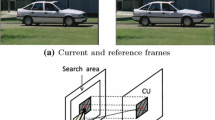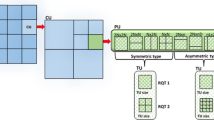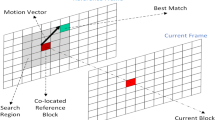Abstract
Low-delay video coding systems are becoming more and more popular with each passing year. However, due to huge size of video data, raw video transmission is not possible, and compression is required. High efficiency video coding (HEVC) standard is able to compress videos at half the bitrate as compared to the previous standard. However, HEVC is extremely complex, and its software implementations are either coding-inefficient or slow. Hardware-based coding systems for HEVC, on the other hand, are not only able to achieve high throughput, but also offer low power consumption and some other benefits, when compared with software-based solutions. However, hardware efficiency can be achieved only when the underlying algorithm is hardware friendly. Of the many video encoder modules, motion estimation (ME) is the most computationally intensive one, which is why it is advisable to carry out ME on a hardware-based system, if high performance is required. Most of the ME algorithms presented in the literature focus only on coding efficiency and not on hardware efficiency. In this article, we present a coding- efficient ME algorithm which is more hardware friendly than most modern implementations. The proposed algorithm achieves a throughput of 4 K@42 frames per second (4 K = 3840 × 2160) at a maximum operating frequency of 200 MHz with no degradation in quality, and is comparable to state of the art algorithms, making it suitable for low delay video coding applications such as eHealth.






Similar content being viewed by others
References
Belghith F, Kibeya H, Loukil H, Ayed MAB, Masmoudi N (2016) A new fast motion estimation algorithm using fast mode decision for high-efficiency video coding standard. J Real-Time Image Proc 11(4):675–691
Bossen F (2012) Common test conditions and software reference configurations, document JCTVC-L1100. JCT-VC, San Jose, CA
Chen Z, Zhou P, He T and others (2002) Fast integer pel and fractional pel motion estimation for JVT, JVT-F. 017, pp 5–13
Chen K, Franko K, Sang R (2021) Structured model pruning of convolutional networks on tensor processing units. arXiv preprint arXiv:2107.04191
Finkelstein SM, Speedie SM, Potthoff S (2006) Home telehealth improves clinical outcomes at lower cost for home healthcare. Telemed J e-Health 12(2):128–136
He G, Zhou D, Li Y, Chen Z, Zhang T, Goto S (2015) High-throughput power-efficient VLSI architecture of fractional motion estimation for ultra-HD HEVC video encoding. IEEE Trans Very Large Scale Integr VLSI Syst 23(12):3138–3142
Healy J-C (2008) Implementing e-Health in Developing Countries, International Telecommunication Union (Draft) 11
HEVC Reference Model (HM) (2017) https://hevc.hhi.fraunhofer.de/svn/svn_HEVCSoftware/. Accessed 15 Feb 2017
Hsieh J-H, Chang, Tian-Sheuan (2013) Algorithm and architecture design of bandwidth-oriented motion estimation for real-time mobile video applications. IEEE Trans Very Large Scale Integr VLSI Syst 21(1):33–42
Huynh-Thu Q, Ghanbari, Mohammed (2008) Scope of validity of PSNR in image/video quality assessment. Electron Lett 44(13):800–801
Jou S-Y, Chang S-J, Chang T-S (2015) Fast motion estimation algorithm and design for real time QFHD high efficiency video coding. IEEE Trans Circuits Syst Video Technol 25(9):1533–1544
Li R, Zeng B, Liou ML (1994) A new three-step search algorithm for block motion estimation. IEEE Trans Circuits Syst Video Technol 4(4):438–442
Liu C, Zhu Q, Holroyd KA, Seng, Elizabeth K (2011) Status and trends of mobile-health applications for iOS devices: a developer’s perspective. J Syst Softw 84(11):2022–2033
Mohammadzadeh N, Safdari, Reza (2014) Patient monitoring in mobile health: opportunities and challenges. Med Archives 68(1):57
Nakamura K, Takano T, Akao C (1999) The effectiveness of videophones in home healthcare for the elderly. Med Care 37(2):117–125
Panayides A, Antoniou ZC, Mylonas Y, Pattichis, Marios S, Pitsillides A, Pattichis, Constantinos S (2013) High-resolution, low-delay, and error-resilient medical ultrasound video communication using H. 264/AVC over mobile WiMAX networks. IEEE J Biomedical Health Inf 17(3):619–628
Pastuszak G, Trochimiuk M (2016) Algorithm and architecture design of the motion estimation for the H.265/HEVC 4K-UHD encoder. J Real-Time Image Proc 12(2):517–529
Purnachand N, Alves LN, Navarro A (2012) Fast motion estimation algorithm for HEVC. In: Consumer electronics - Berlin (ICCE-Berlin), 2012 IEEE International Conference on, pp 34–37. https://doi.org/10.1109/ICCE-Berlin.2012.6336494
Sanchez G, Porto M, Agostini L (2013) A fast hardware-friendly motion estimation algorithm and its VLSI design for real time ultra high definition applications. In: Circuits and Systems (LAS- CAS), 2013 IEEE Fourth Latin American Symposium on. IEEE, pp 1–4
Sanchez G, Porto M, Agostini L (2013) A hardware friedly motion estimation algorithm for the emergent HEVC standard and its low power hardware design. In: IEEE International Conference on Image Processing, IEEE, pp 1991–1994
Sanchez G, Zatt B, Porto M, Agostini L (2015) Hardware-friendly HEVC motion estimation: new algorithms and efficient VLSI designs targeting high definition videos. Analog Integr Circuits Signal Process 82(1):135–146
Shahid MU, Ahmed A, Martina M, Masera G, Magli E (2015) Parallel H. 264/AVC fastrate- distortion optimized motion estimation by using a graphics processing unit and dedicated hardware. IEEE Trans Circuits Syst Video Technol 25(4):701–715
Sinangil ME, Sze V, Zhou M, Chandrakasan AP (2013) Cost and coding efficient motion estimation design considerations for high efficiency video coding (HEVC) standard. IEEE J Sel Top Signal Process 7(6):1017–1028
Singh K, Ahamed SR (2018) Computationally efficient motion estimation algorithm for HEVC. J Signal Process Syst 90(12):1713–1727
Stone JH (2009) A clinician’s pearls and myths in rheumatology, vol 2009. Springer
Tham J, Ashraf A (1998) A novel unrestricted center-biased diamond search algorithm for block motion estimation. IEEE Trans Circuits Syst Video Technol 8(4):369–377
Tourapis AM, Au OC, Liou ML (2002) Highly efficient predictive zonal algorithms for fast block-matching motion estimation. IEEE Trans Circuits Syst Video Technol 12(10):934–947
Wali I, Kessentini A, Ayed MAB, Masmoudi N (2019) Fast inter-prediction algorithms for spatial scalable high efficiency video coding SHVC, Signal. Image and Video Processing 13(1):145–153
Wiegand T, Sullivan GJ, Bjøntegaard G, Luthra A (2003) Overview of the H. 264/AVC video coding standard. IEEE Trans Circuit Syst Video Technol 13(7):560–576
Xu W, Yin S, Liu L, Liu Z, Wei S (2015) High-performance motion estimation for image sensors with video compression. Sensors 15(8):20752–20778
Yang J, Jiang G, Zhang L, Zhang G, Wu C (2009) Multiview video coding based on rectified epipolar lines. In: Information, Communications and Signal Processing, 2009. ICICS 2009. 7th International Conference on. IEEE, pp 1–5
Yang S-H, Jiang J-Z, Yang H-J (2014) Fast motion estimation for HEVC with directional search. Electron Lett 50(9):673–675
Yilmaz AA et al (2020) A novel action recognition framework based on deep-learning and genetic algorithms. IEEE Access 8:100631–100644
Zatt B, Shafique M, Bampi S, Henkel J (2011) A low-power memory architecture with application-aware power management for motion & disparity estimation in multiview video coding. In: Proceedings of the international conference on computer-aided design. IEEE Press, pp 40–47
Author information
Authors and Affiliations
Corresponding author
Ethics declarations
Conflict of interest/Competing interests
It is confirmed that authors of this manuscript have no conflict of interest/competing interests.
Additional information
Publisher’s note
Springer Nature remains neutral with regard to jurisdictional claims in published maps and institutional affiliations.
Rights and permissions
Springer Nature or its licensor (e.g. a society or other partner) holds exclusive rights to this article under a publishing agreement with the author(s) or other rightsholder(s); author self-archiving of the accepted manuscript version of this article is solely governed by the terms of such publishing agreement and applicable law.
About this article
Cite this article
Siddique, A., Bhatti, A., Butt, A.D. et al. A hardware-friendly motion estimation algorithm for the HEVC standard in the context of low-delay video coding. Multimed Tools Appl 82, 16519–16532 (2023). https://doi.org/10.1007/s11042-022-14178-z
Received:
Revised:
Accepted:
Published:
Issue Date:
DOI: https://doi.org/10.1007/s11042-022-14178-z




